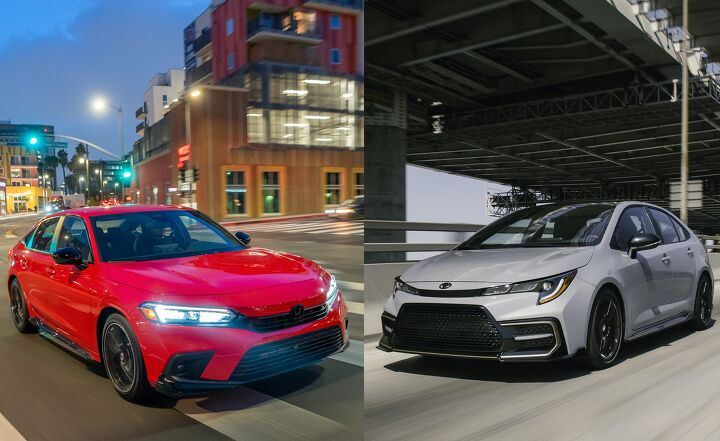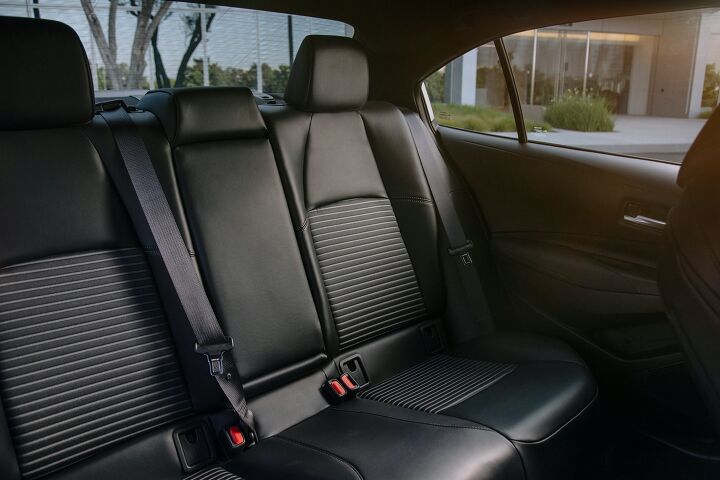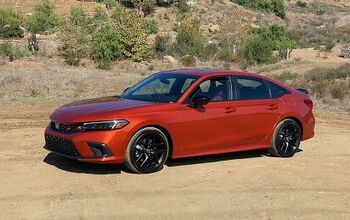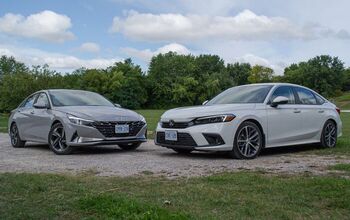Honda Civic Vs Toyota Corolla: Which Compact Sedan is Right For You?

Crossovers might be the norm but the compact sedan isn’t out of the running yet.
It’s no secret that compact crossovers are more popular than ever before. They might essentially be large hatches on stilts, but the boxy shape and edgy styling seem to attract customers in throngs. Where some manufacturers have all but given up on the compact sedan, it is heartening to see the Honda Civic and Toyota Corolla soldier on.
Get a Quote on a New Honda Civic vs Toyota CorollaWhere most sedans lose out to compact crossovers, the aforementioned titans of the family sedan segment are still in high demand. The Civic and the Corolla offer an ideal option for anyone looking for a compact, functional and affordable family vehicle. While short on luggage capacity compared to crossovers, their comfort levels and practicality cannot be questioned. With the 2022 Civic, Honda has pushed the compact sedan envelope even further. So does its biggest home turf rival, the Toyota Corolla still stand a chance against the Civic or is the Honda now the go-to choice for compact sedans? Let’s find out.
Cabin and Cargo Space
Civic: While the 11th generation Civic has barely grown compared to the car it replaces, the distance between the wheels has increased by 1.5 inches (38 mm). As a result, the Civic now offers more space inside the cabin than before. Without the sunroof, front passengers get 39.3 inches (998 mm) of headroom while rear occupants get 37.1 inches (942 mm) of it. The power sliding sunroof takes almost two inches out of the front headroom, rear head space though remains constant.
As for legroom, the 2022 Civic offers 42.3 inches (1,074 mm) up front and 37.4 inches (950 mm) of legroom at the rear bench. The trunk can swallow 14.8 cu-ft (418 liters) of luggage with ease.
Corolla: At 182.3 inches (4,630 mm) Corolla is only a little over an inch shorter compared to the Civic (184.0 inches) but coincidentally has the same wheelbase as the previous Civic. With 106.3 inches (2,700 mm) between the wheels, the Corolla offers 34.8 inches of rear legroom, almost three inches less compared to the Civic. It is also slightly less spacious in the front with 42 inches (1,067 mm) of legroom.
It does, however, offer 38.1 inches (968 mm) of headroom in the front with the sunroof which is an inch more compared to the Civic. Rear headroom though is the same in both cars. The Corolla also offers 13.1 cu-ft (370 liters) of luggage capacity.
Bottom Line: While both, the Honda Civic and the Corolla offer similar levels of headroom, the Civic offers significantly more legroom in the rear. It offers a higher cargo capacity as well.
Powertrains
Civic: Honda currently offers the Civic sedan with two powertrains but unlike the Corolla, there is no hybrid option here. A 2.0-liter four-cylinder turbo engine powers the two base trims and makes 158 hp of max power and 138 lb-ft of peak torque. The other engine is the 1.5-liter turbocharged four-cylinder unit found elsewhere on the Honda lineup. It makes 180 hp and 177 lb-ft of max torque and is only available with the EX and Touring trims.
Both engines pair with a CVT gearbox and drive the front wheels.
Corolla: The Corolla comes with a choice of three powertrains, two gas, and a hybrid. Lower trims like the L, LE, and the XLE come with a 1.8-liter naturally aspirated four-cylinder motor making a rather conservative 139 hp of max power and 126 lb-ft of peak torque. The other is the 2.0-liter four-cylinder which makes 169 hp and 151 lb-ft of peak torque. While the 1.8-liter motor is only available with a CVT gearbox, the 2.0-liter engine comes with both CVT and a six-speed manual. strangely though, the manual isn’t available on the XSE trims and only comes with the SE.
Lastly, the hybrid powertrain employs the 1.8-liter motor which pairs with a 53 kW electric motor. Peak system power stands at 121 hp while the engine makes 105 lb-ft of max torque. Needless to say, the hybrid system pairs with an iCVT gearbox and drives the front wheels.
Bottom Line: The Honda Civic offers a more powerful engine lineup but what the Toyota lacks in performance it makes up for in variety by offering a manual gearbox and a hybrid powertrain.
Fuel Economy
Civic: Both the base trims, LX and Sport are powered by the 2.0-liter motor but yet return different mileage figures. The LX promises 31 mpg (7.7 L/100 km) in the city, 40 mpg (6.0 L/100 km) on the highway while the overall efficiency stands at 35 mpg (6.9L/100 km). With 33 mpg (7.8 L/100 km) overall and 37 mpg (6.3 L/100 km) on the highway, the Sport trim fairs slightly worse. Its city mileage stands at 30 mpg (7.1L/100 km).
SEE ALSO: 2022 Honda Civic Review: First DriveComing to the turbo motor, in the city, the 1.5-liter engine offers 33 mpg in the EX trim and 31 mpg (7.6 L/100 km) in the Touring trim. The highway efficiency stands at 42 and 38 mpg (6.1 L/100 km) respectively while the overall figure is 36 and 34 mpg (6.9 L/100 km) for the EX and Touring trims
Corolla: Just like the Civic, each trim of the Corolla offers different mileage as well but unlike the Honda, the difference here is minor. The 2.0-liter engine promises 29 mpg (8.2 L/100 km) in the city, 36 (6.5L/100 km) on the highway, and 32 mpg (7.4 L/100 km) overall with the manual in the SE trim. In the Apex trim the efficiency drops by 1 mpg. Similarly, when equipped with the CVT, the 2.0-liter returns 31 mpg (7.6 L/100 km) in the city, 40 (5.8L/100 km) on the highway, and 34 mpg (6.7 L/100 km) overall and it drops by 1 mpg in the Apex trim.
The 1.8-liter engine offers 30 mpg (7.9 L/100 km) in the city, 38 mpg (6.1L/100 km) on the highway, and 33 (7.1 L/100) km overall in the L and LE trims. It drops by 1 mpg in the XLE. But the hybrid is obviously the most fuel-efficient by far offering 53 mpg (4.4 L/100 km) in the city and 52 (4.5L/100 km) on the highway and overall.
Bottom Line: Gas versions of both the Civic and the Corolla offer similar mileage. Though the Honda is slightly more fuel-efficient, it doesn’t even come close to the frugality the Corolla hybrid offers.
Tech and Features
Civic: Honda offers LED headlamps as standard across the Civic range along with the climate control system. It also offers a 7.0-inch touchscreen with Apple CarPlay and Android Auto as standard as well. There is a 9.0-inch screen on offer as well but is only available on the top Touring trim. The larger screen also comes with wireless Apple CarPlay and Android Auto. A dual-zone climate control is also available with the top two trims only.
An eight-way power-adjustable driver’s perch and four-way power-adjustable passenger seat are only available on the Touring trim. Plus, features like leather upholstery, HomeLink system, and the 10.2-inch all-digital instrument cluster, and the nine-speaker premium Bose audio system, are all exclusive to the top trim.
Corolla: There is no climate control in the base L trim of the Corolla. It is however available from LE trim onwards but is a single-zone system only. A 7.0-inch touchscreen comes standard while all trims above the base L get the larger 8.0-inch screen. All systems come with Android Auto and Apple CarPlay but need to be tethered.
Only the XSE trims offer a 7.0-inch TFT multi-information display for the driver, all other trims make do with a smaller 4.0-inch screen. There is also no power adjustment for the passenger across the lineup, only the driver gets an 8-way power-adjustable perch, that too on the XSE trims. A premium nine-speaker premium JBL audio system is available but only as part of a package even on the XSE trims.
Bottom Line: The Civic offers more equipment as standard compared to the Corolla. While the Corolla is decently equipped, no premium audio system even in the top trim can be seen as a glaring omission.
Safety
Civic: Honda offers a host of safety features as standard on the Civic. Everything including forward collision warning, lane departure warning, auto emergency braking, lane-keeping assist, adaptive cruise control with traffic jam assist, and traffic sign recognition are all part of the standard kit. Only blind-spot monitoring is reserved for the top two trims while rear cross-traffic alert and low-speed braking control are only available with the Touring trim.
Corolla: Just like the Civic, the Corolla too comes with features like forward collision warning, lane-keeping assist, and auto emergency braking as standard. It also offers two versions of dynamic cruise control. The full-speed cruise control is available across the range except for the SE trims. Also, just like the Civic, blind-spot monitoring with rear cross-traffic alert is only available with the XSE and XLE trims.
SEE ALSO: 2021 Toyota Corolla Apex Edition Review: Halfway ThereBottom Line: Both Honda Civic and the Corolla are quite evenly matched in terms of safety equipment.
Pricing
Civic: Honda offers the Civic in four trims. The base LX trim starts from $22,695 including destination and comes with LED headlamps and a single-zone climate control as standard. As we mentioned before, the LX comes with the less powerful 2.0-liter powertrain which also powers the Sport trim. Prices for the Sport trim start from $24,095 and it features some nifty exclusive features. Things like sport pedals, paddle shifters, and 18-inch wheels are exclusive the Sport.
Starting from $25,695, the EX is the next trim in the lineup. It comes with the 1.5-liter turbo and a sliding moonroof along with a dual-zone climate control system and blind-spot detection with rear cross-traffic alert. At the top sits the Touring trim starting from $29,295 including destination. Being the top pick of the Civic lineup it comes with tons of exclusive features like a 9.0-inch infotainment screen. wireless Apple CarPlay and Android Auto and a 10.2-inch all-digital instrument cluster.
Corolla: Toyota clearly believes in offering something for everyone and the Corolla is no exception. It is available in nine trims in total including two special editions and a hybrid. The base L trim starts from $21,070 including destination while the LE with climate control as standard starts from $21,520. Next up is the SE and is the only core trim that comes with the six-speed manual. Starting from $23,520, you can consider this the base trim for the 2.0-liter motor. For just $700 more you can get the SE Nightshade Edition but you will have to make do with a CVT.
The XLE starts from $25,470 and is the top trim for the 1.8-liter motor. But the top core trim here is the XSE which starts from $26,970. Then there are the Apex special editions which are available with the SE and XSE trims. The Apex SE starts from $25,215 and is the only Apex trim to offer a manual gearbox, the XSE is only available with CVT and starts from $29,355. As for the hybrid, it is only available with the LE trim and starts from $24,645.
Bottom Line: Where the Corolla offers a wide lineup and a host of add-on packages including active safety features like adaptive cruise control and blind-spot detection, the Civic offers a more consolidated lineup with better standard equipment even if it demands a slight premium over the Corolla.
Verdict: Honda Civic vs Toyota Corolla
While the price difference between the two is only marginal, the Civic and the Corolla are quite different from one another. Where the Civic offers a limited number of well-equipped trims, the Corolla offers innumerable combinations of trims and packages to fit almost every requirement and need. But there is no denying that as a family car, the Honda offers a better package. It not only offers better standard equipment, but the top trims also offer better tech and a more spacious cabin compared to the Toyota. Yes, it demands a premium over its primary rival but it is also the newer car and considering what it offers at the price, the Honda Civic sedan is the ideal choice.
Become an AutoGuide insider. Get the latest from the automotive world first by subscribing to our newsletter here.

More by Kshitij Sharma

















































Comments
Join the conversation